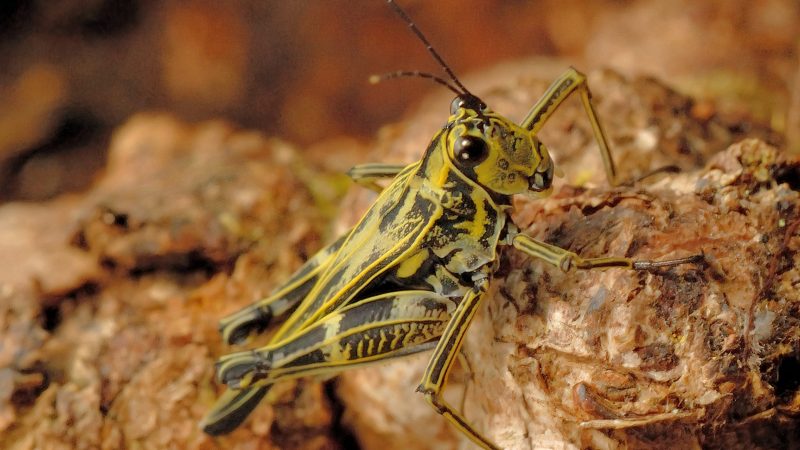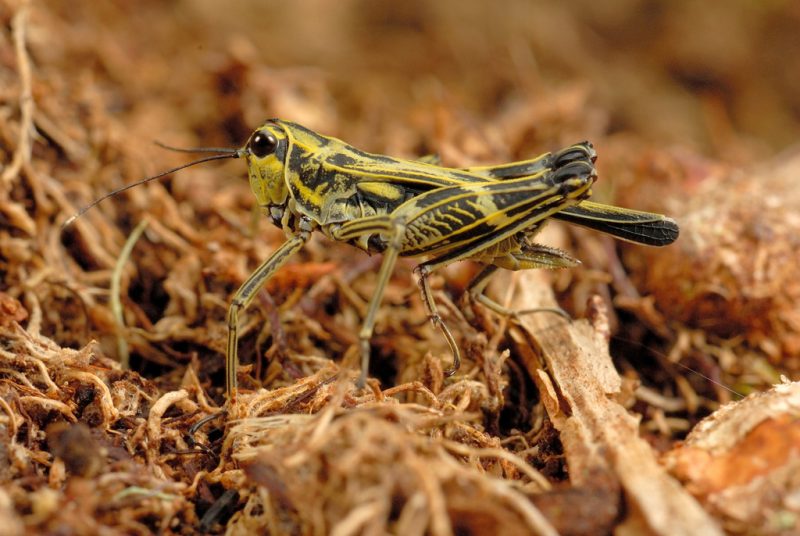
New nameless grasshopper
According to a December 14, 2021, science paper in the open-access, peer-reviewed Journal of Orthoptera Research:
A heated debate on whether a new species should be described without a physical specimen … has been ongoing for a long time.
A case in point is the new nameless Scaria – announced this month in that same science paper – discovered via old photographs on the website iNaturalist. This site bills itself as a community of naturalists. Community members share photos of their wildlife observations, looking for crowdsourced identifications. In 2018, Robert Sindaco of the Institute for Wood Plants and the Environment in Italy posted images on iNaturalist of a pygmy grasshopper he’d photographed in a Peruvian rainforest in 2008. The images drew the attention of students in Croatia, including Niko Kasalo at the University of Zagreb. The students, along with their professor and Sindaco, have now announced the new grasshopper discovery. Kasalo told EarthSky that the new grasshopper:
… has become the symbol of the efforts of citizen scientists and their role in discovering new species.
EarthSky 2022 lunar calendars now available! They make great gifts. Order now. Going fast!
Social media and the nameless Scaria
It’s not common practice to name a new species based on photos alone. Generally, scientists collect new species from their habitats and then name them, in accordance with rules and standards maintained by the International Code of Zoological Nomenclature.
But the only known sightings of this new grasshopper species are from the photographs posted at iNaturalist. And there is no mechanism in science for naming a species seen in photos only.
So the researchers could describe their new species of pygmy grasshopper, but they couldn’t name it. In fact, an earlier version of their paper – which attempted to name the grasshopper – got a rejection from the journal. Hence the nameless Scaria.
Connecting people and nature
Even if they couldn’t name the new grasshopper, these citizen scientists felt it was important to describe the species in their science paper. They said:
By the time a scientist collects, examines, and describes one new species, several more have gone extinct … Every new species’ description serves as a reminder of those that couldn’t be studied in time and are now irretrievably lost.
Social media sites such as iNaturalist or, in astronomy, Zooniverse – which help citizens get involved in science – let people feel a part of the natural world around them. These sites also help people understand how science works. These authors said:
Only by interacting with nature we can truly feel how much we might lose if we don’t take care of it. And care is urgently needed.

Bottom line: Old photos from social media led to the discovery of a new species of pygmy grasshopper, which currently has the nickname of the nameless Scaria.
Read more: Video and photos: Rich biodiversity in South American rainforest
The post A nameless grasshopper, found via social media first appeared on EarthSky.
from EarthSky https://ift.tt/3swfkcz

New nameless grasshopper
According to a December 14, 2021, science paper in the open-access, peer-reviewed Journal of Orthoptera Research:
A heated debate on whether a new species should be described without a physical specimen … has been ongoing for a long time.
A case in point is the new nameless Scaria – announced this month in that same science paper – discovered via old photographs on the website iNaturalist. This site bills itself as a community of naturalists. Community members share photos of their wildlife observations, looking for crowdsourced identifications. In 2018, Robert Sindaco of the Institute for Wood Plants and the Environment in Italy posted images on iNaturalist of a pygmy grasshopper he’d photographed in a Peruvian rainforest in 2008. The images drew the attention of students in Croatia, including Niko Kasalo at the University of Zagreb. The students, along with their professor and Sindaco, have now announced the new grasshopper discovery. Kasalo told EarthSky that the new grasshopper:
… has become the symbol of the efforts of citizen scientists and their role in discovering new species.
EarthSky 2022 lunar calendars now available! They make great gifts. Order now. Going fast!
Social media and the nameless Scaria
It’s not common practice to name a new species based on photos alone. Generally, scientists collect new species from their habitats and then name them, in accordance with rules and standards maintained by the International Code of Zoological Nomenclature.
But the only known sightings of this new grasshopper species are from the photographs posted at iNaturalist. And there is no mechanism in science for naming a species seen in photos only.
So the researchers could describe their new species of pygmy grasshopper, but they couldn’t name it. In fact, an earlier version of their paper – which attempted to name the grasshopper – got a rejection from the journal. Hence the nameless Scaria.
Connecting people and nature
Even if they couldn’t name the new grasshopper, these citizen scientists felt it was important to describe the species in their science paper. They said:
By the time a scientist collects, examines, and describes one new species, several more have gone extinct … Every new species’ description serves as a reminder of those that couldn’t be studied in time and are now irretrievably lost.
Social media sites such as iNaturalist or, in astronomy, Zooniverse – which help citizens get involved in science – let people feel a part of the natural world around them. These sites also help people understand how science works. These authors said:
Only by interacting with nature we can truly feel how much we might lose if we don’t take care of it. And care is urgently needed.

Bottom line: Old photos from social media led to the discovery of a new species of pygmy grasshopper, which currently has the nickname of the nameless Scaria.
Read more: Video and photos: Rich biodiversity in South American rainforest
The post A nameless grasshopper, found via social media first appeared on EarthSky.
from EarthSky https://ift.tt/3swfkcz

Aucun commentaire:
Enregistrer un commentaire